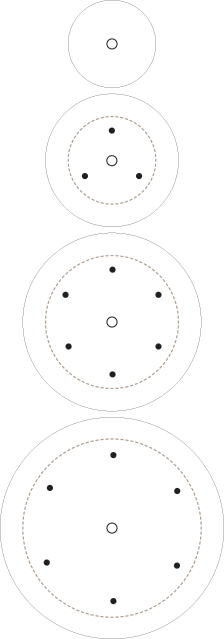Dowelling your wedding cake
It’s really important to create internal structure for a tiered cake so that it doesn’t cave in, tip over, slide or create any other potentially disastrous situation. Even if you are planning on mounting your cake on site, I recommend you dowel the tiers in advance to create stability once assembled.
suggested dowel positioning for tiers (from top down)
Always make a hole in the centre of each cake base before starting (it should be the same diameter as the wooden dowel you will drive through the centre of the cake).
Use wooden and plastic dowels that are made specifically for use with food products to support the weight of the tiers above.
Make sure to give a diagram of the internal structure of the cake to the person in charge with the number of dowels and positioning in each tier so they can be removed when cutting the cake.
I’ve found the best way to cut the wooden and plastic dowels is with a PVC cutter (I bought mine at Home Depot in the plumbing section). You can also use a serrated knife or a small saw but be careful! (This is the one I have)
Measure the height of each dowel very carefully - they should be exactly level with the top of your cake (already covered in buttercream or fondant, whichever you are using) AND of equal height to each other so the next cake sits securely flat and level on top. (I use a “bulls-eye” level like this one but a regular one will do as well)
Dowel each tier before starting to assemble your cake tiers.
Make sure the top of each cake tier is level before starting to measure and cut the dowels.
When you are ready to assemble the tiers, start from the bottom up, inserting each tier onto the central dowel and working your way up.
Estrutura interna do bolo
É extremamente importante construir uma estrutura dentro de cada andar para evitar que o bolo caia. Mesmo que proceda à montagem no local, não deve saltar este passo pois confere estabilidade ao bolo.
Faça um buraco no centro da base (entrebolo) de cada andar antes de começar.
Deve usar sempre paus de madeira ou tubos de plástico (aprovados pela Autoridade Alimentar) para suportar o peso dos andares de cima.
Deixe indicações ao coordenador do evento (um diagrama) com o número e posição dos paus e tubos para que sejam removidos durante o corte.
Descobri que a melhor maneira de cortar os paus e os tubos é com um cortador de PVC, mas também pode usar uma faca de serrilha afiada ou uma pequena serra.
A altura de cada suporte deve ser medida com precisão para ser igual à altura do bolo já coberto com creme de manteiga e/ou pasta de açúcar.
Cada andar deve estar completamente pronto antes de começar a montar o bolo.
Certifique-se que cada andar está nivelado antes de medir os suportes.
Comece de baixo para cima inserindo cada andar no suporte central.
Para mais dicas sobre bolos de casamentos, podem comprar o meu livro “A Bíblia dos Bolos de Casamento” na Amazon:




